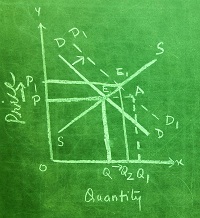We distinguish between two types of market situation
in this situation
1) Perfectly competitive market
2) Imperfectly competitive market
The behaviour of Toal revenue, Average revenue and
Marginal revenue will be different in the two types of market.
Relationship
between TR, AR and MR under Perfect Competition
A firm under perfect competition is able to sell
additional units of output at the ruling price. It is not required to reduce
the price to sell more.
Reason:
As perfect competition is a market structure where
there are large number of firms, so increase or decrease in production by any
one firm do not affect in total supply in the whole market and also on price.
The collective force of demand and supply determines price in perfect
competition which prevails in the market.
So each firm sells at the prevailing price (so do
not reduce the price to sell more).
So firms are price taker and their demand curve
is perfectly
elastic.
Tabular
Relationship between TR, AR and MR under Perfect Competition
Units of output
(Q)
|
Price
( P)
|
AR
(TR / Q)
|
TR
(P x Q)
|
MR (TRn- TRn-1)
|
|
1
2
3
4
5
|
10
10
10
10
10
|
10
10
10
10
10
|
10
20
30
40
50
|
10 – 0 = 10
20 – 10 = 10
30 – 20 = 10
40 – 30 = 10
50 – 40 = 10
|
|






